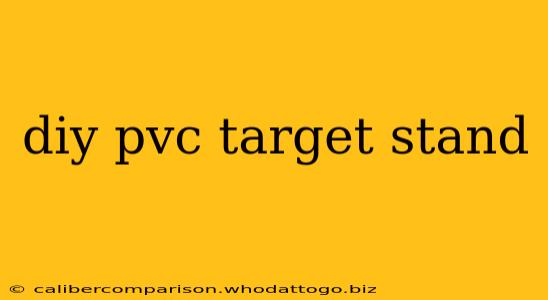Building your own target stand can save you a significant amount of money compared to buying a pre-made one. This DIY PVC target stand project is perfect for the budget-conscious shooter who values practicality and customization. This guide will walk you through the process, from planning and material selection to assembly and setup. Whether you're a seasoned marksman or just starting out, this project is achievable with basic tools and a little patience.
Planning Your PVC Target Stand: Size and Design Considerations
Before heading to the hardware store, carefully consider the size and design of your target stand. The dimensions will depend on the size of your targets and your shooting needs. Here are some key aspects to plan:
- Target Size: Measure your largest target. The stand needs to be wide enough to accommodate it comfortably, with some extra space for stability.
- Height: Determine the ideal height for your shooting position. Consider the type of shooting you'll be doing (e.g., archery, air rifle, pellet gun). A slightly adjustable height can be beneficial.
- Stability: A stable stand is crucial for safety. Consider the weight of your targets and the wind conditions in your shooting area. A wider base provides greater stability.
- Portability: Do you need a portable stand or a more permanent setup? A lighter, more easily disassembled stand offers portability, while a more robust design might be better suited for a fixed location.
Gathering Your Materials: The PVC Target Stand Shopping List
This project uses readily available PVC pipes and connectors. Here's a suggested materials list, remember to adjust quantities based on your chosen design:
- PVC Pipes: Various lengths and diameters are needed, depending on your design. Schedule 40 PVC is recommended for its durability. Consider using different diameters for the base and support structure for added strength.
- PVC Connectors: Elbows (90°), Tees (3-way connectors), and possibly crosses (4-way connectors) are essential for creating the stand's structure. Choose connectors that match the diameter of your pipes.
- PVC Cement: A high-quality PVC cement is crucial for creating strong, water-resistant joints.
- Measuring Tape and Pencil: Accurate measurements are vital for a well-functioning stand.
- PVC Cutter or Saw: A PVC cutter provides clean cuts, but a hacksaw can also be used.
- Safety Glasses: Always wear safety glasses when working with PVC cement and cutting pipes.
- Optional: Sandpaper: For smoothing any rough edges on the cut PVC pipes.
Assembling Your PVC Target Stand: A Step-by-Step Guide
This section provides a general guide; specific instructions will vary depending on your chosen design. Remember to always consult your chosen plan or blueprint.
-
Cut the PVC Pipes: Using your measurements, carefully cut the PVC pipes to the required lengths. Ensure clean, square cuts for optimal connector fitting.
-
Dry Fit the Connectors: Before applying PVC cement, dry fit all the pipes and connectors to ensure a proper fit and identify any adjustments needed.
-
Apply PVC Cement: Generously apply PVC cement to the ends of the pipes and inside the connectors. Quickly connect the pipes and hold them firmly in place until the cement sets (check the cement's instructions for setting time).
-
Assemble the Base: Begin by assembling the base structure, creating a stable foundation for the stand. Consider using a wider base for greater stability.
-
Build the Support Structure: Connect the base to the vertical supports, ensuring they are securely attached and perpendicular.
-
Attach the Target Holder: Design and attach a suitable target holder to the top of the stand. This could be a simple horizontal pipe or a more elaborate system depending on your needs.
Tips for Success and Customization
-
Consider adding weights to the base: For increased stability, consider adding weights to the base, such as bags of sand or rocks.
-
Customize your design: This guide offers a framework; feel free to modify the design to suit your specific needs and preferences. Experiment with different heights, widths, and configurations.
-
Choose the right PVC diameter: Larger diameter PVC pipes offer greater strength and stability.
-
Ensure all connections are secure: A poorly cemented joint can lead to instability and potential accidents.
Building a DIY PVC target stand is a rewarding project that combines practicality, cost-effectiveness, and customization. With careful planning and execution, you’ll have a sturdy and reliable target stand tailored to your specific shooting needs. Remember safety first! Always practice safe shooting habits and use appropriate eye and ear protection.

